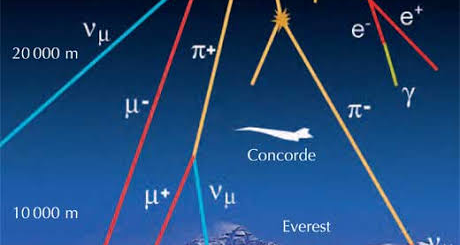Neutrinos that travel faster than light
Since I have been asked about this twice now, I’ve decided to write up this note about what’s going on lately in the world of neutrino physics.
What is a neutrino?
A neutrino is a small, nearly massless particle – even smaller than the teeny electron. It also has no charge, thus is can travel through matter with little chance of interacting with it (hitting a nucleus of some atom or a random electron). It was theorized in the 1930s when looking at how a neutron will decay into a proton plus an electron. The measured energy of the two final particles was smaller than that of the original neutron so a third particle was postulated that must contain the other, missing energy. The amount was very tiny and it wasn’t until 1942 that experiments could verify its existence. Cut to the late 1970s and early 80s where this particle was discovered to have mass, although a very tiny amount. Then it was found that of the 3 types of neutrinos discovered, each had a way of turning into the other types through a process dubbed “neutrino oscillation”.
What’s all this about passing through matter?
Because they are so infinitesimally small, have no charge, and are leptons (a type of subatomic particle), neutrinos do not feel 2 of the 4 known forces: electro-magnetic and the strong nuclear force. They do succumb to gravity but because of their small mass the effect is very, very weak. The only force they do feel in practice is that of the weak nuclear force, the force that binds subatomic particles together. The distance over which this force acts is of the diameter of the neutrino itself. In other words, a neutrino in flight would have to be passing by the interior of the nucleus of some atom in order to feel itself being drawn off course. Atoms are an angstrom in diameter, that’s 0.0000000001 meters. The nucleus of an atom, however, is 0.0001 angstroms, a very tiny part of the space taken up by an atom. What you perceive as a solid object is, in fact, mostly empty space. And I mean “empty” – there’s nothing there. What keeps us from passing through walls then? The fact the the charged electrons of the atoms in our body are electrically repelled by the electrons surrounding the atoms of other matter. The tiny neutrino has no such limitation.
The sun, being a nuclear reactor, produces trillions upon trillions of neutrinos that stream through the earth every moment. Several trillion neutrinos pass through your body every second. Only 1 in 10 billion (10,000,000,000) neutrinos will randomly collide with the nucleus of some atom during the trip through the Earth. That should give you same idea of the sense of empty space that the neutrino “sees”.
If they pass through matter, how do we detect them?
If you could send a single neutron into a block of lead it would require a lead brick 1 light-year thick to guarantee with near certainty that the neutrino would hit an atomic nucleus. That’s the distance light travels in one year, 5.86 trillion miles. That makes creating a neutrino detector – a device where you have to have a successful collision with a neutrino – fairly daunting. You cannot obtain that much lead so you work the other angle. You make a modest size detector of lead and other supporting electronics, and place them in the path of a large, potent source of neutrinos; a source so powerful that among the trillions of neutrinos to come flying out, you’re pretty much guaranteed to capture one every now and then. This is what is in place at the Gran Sasso Laboratory in Italy. It is a detector designed to capture neutrinos produced by powerful particle collisions at CERN.
The OPERA experiment
The experiment involves creating a batch of neutrinos at CERN and firing them off towards the Gran Sasso detector. The purpose of the experiment is to verify that neutrinos can change “flavors”. CERN produces a type of neutrino known as the muon neutrino. During flight, some of these neutrinos will change to become tau neutrinos. It is tau neutrinos that the Gran Sasso was built to detect.
It happens that roughly 700 km is the flight distance where this effect is most readily observed. The straight line path from CERN to Gran Sasso is underground, which again makes no difference to the neutrinos, and is very accurately known, 730 km plus or minus 20 cm.
In the experiments which began in 2008 CERN muon neutrinos were sent towards Gran Sasso’s tau neutrino detector. Part of the data collected was the time of flight, or how long it took for the neutrinos to arrive. However, it isn’t a simple matter of firing off some neutrinos at the same time one starts a stopwatch and then stopping the watch when neutrinos are detected. There’s no precise way to know when the particle collisions in CERN’s accelerators have taken place (producing neutrinos) without detecting them, and thus removing them from the experiment. CERN scientists only know that when they run the beam for so much time at a certain energy, they will get a certain amount of neutrinos. They have a probability calculation to do on how many neutrinos were created and roughly what time they left CERN.
Next, the detectors in Italy go off, marking an end time that is then corroborated with CERN folks. From the first such neutrino detected in 2010, over 15,000 neutrinos had been detected. When they did the complex calculations to discover the flight times they found that the neutrinos seem to have travelled faster than light would have travelled. This is the situation announced on 9/23/2011.
It’s important to note that only the media have reported that a faster-than-light particle has been discovered. The actual scientific article only explains their measurements, the final calculations, their search for other errors they may have forgotten about, and then a plea for others to chime in to help explain things. They explicitly state that they are offering no theoretical explanations at this time.
Fermilab may be the first laboratory to help verify these measurements, or more likely discover the source of error. It’s already part of the MINOS experiments which look to discover the same type of neutrino oscillations. Fermilab accelerators began producing neutrinos and sending them to detectors buried in the Soudan mines in Minnesota, 735km away. They hope to be able to shed light (no pun intended) on this situation some time in 2012.
You can read a more detailed write-up on the CERN/Gran Sasso experiments here.
[UPDATE: No, neutrinos do not travel faster than light after all.]
Following the discovery of a loose fiber optic cable that had introduced a timing delay in their readings, subsequent measurements at CERN have found that neutrinos travel at the speed of light or perhaps a little less. This has also been confirmed elsewhere. C.f. this report in Nature.



Recent Comments